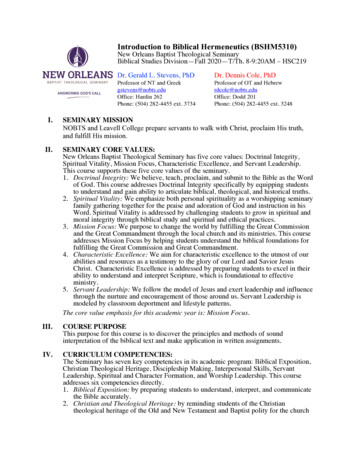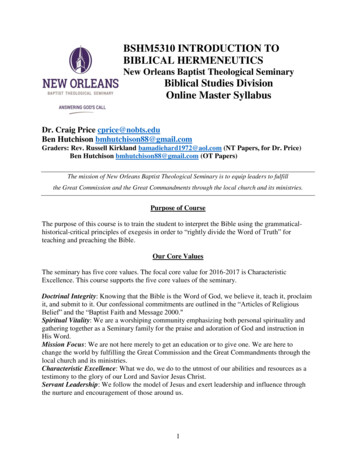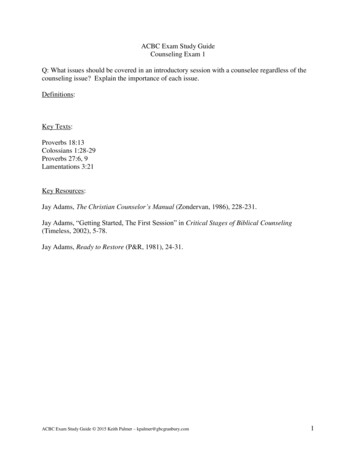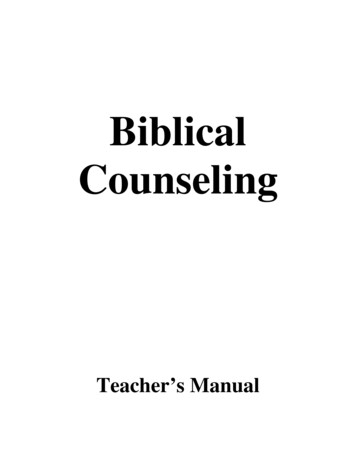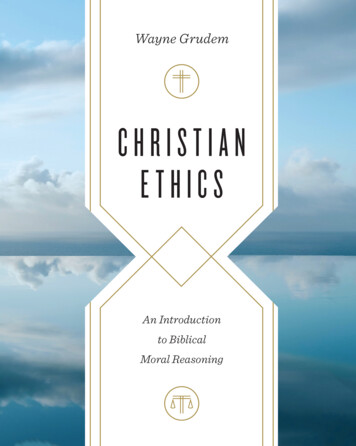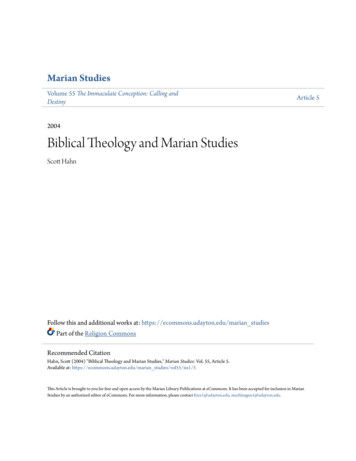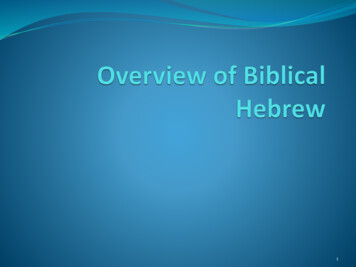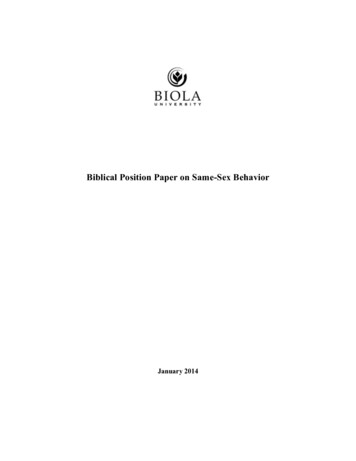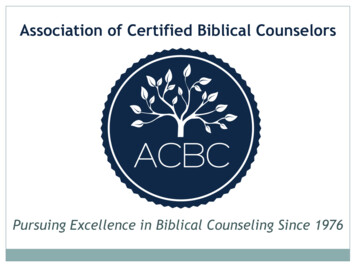
Transcription
An Introductionto Womanist Biblical InterpretationNyasha JuniorPurchase Now from Your Preferred Retailer
2015 Nyasha JuniorFirst editionPublished by Westminster John Knox PressLouisville, Kentucky15 16 17 18 19 20 21 22 23 24—10 9 8 7 6 5 4 3 2 1All rights reserved. No part of this book may be reproduced or transmitted in any form orby any means, electronic or mechanical, including photocopying, recording, or by anyinformation storage or retrieval system, without permission in writing from the publisher. For information, address Westminster John Knox Press, 100 Witherspoon Street,Louisville, Kentucky 40202-1396. Or contact us online at www.wjkbooks.com.Scripture quotations from the New Revised Standard Version of the Bible are copyright 1989 by the Division of Christian Education of the National Council of the Churches ofChrist in the U.S.A., and are used by permission.Book design by Sharon AdamsCover design by Lisa Buckley DesignCover art: Afro-Girl (Aqua) Kim WilsonLibrary of Congress Cataloging-in-Publication DataJunior, Nyasha.An introduction to womanist biblical interpretation / Nyasha Junior. -- First edition.pages cmIncludes bibliographical references and index.ISBN 978-0-664-25987-7 (alk. paper)1. Bible--Black interpretations. 2. Womanist theology. 3. Bible--Feminist criticism. I.Title.BS521.2.J86 2015220.6082--dc232015014669The paper used in this publication meets the minimum requirements of the AmericanNational Standard for Information Sciences—Permanence of Paper for Printed LibraryMaterials, ANSI Z39.48-1992.Most Westminster John Knox Press books are available at special quantity discountswhen purchased in bulk by corporations, organizations, and special-interest groups. Formore information, please e-mail SpecialSales@wjkbooks.com.
This book is dedicated to my first teacher,my mother,Abbie Gale Junior
ContentsPrefaceixIntroductionxiPart IHISTORICAL BACKGROUND1. Three “Waves” of Feminism32. Feminist Biblical Interpretation: Forerunners193. Womanist Biblical Interpretation: Forerunners39Part IICONTEMPORARY SCHOLARSHIP4. Womanist Approaches in Religious-Studies-Related Fields575. Feminist Biblical Interpretation766. Womanist Biblical 45
PrefaceIn In Search of Our Mothers’ Gardens, Alice Walker explains, “I write all the thingsI should have been able to read.”1 I am an African American woman, a HebrewBible scholar, and teacher, and I wish that I had been able to read an introductionto womanist biblical interpretation when I was in graduate school. While I drew onwomanist discourse for my dissertation in Old Testament at Princeton TheologicalSeminary, I had never taken a course in feminist or womanist biblical interpretation,and I found few resources on womanist approaches in biblical studies. As a professor,I find that there are still relatively few resources on womanist biblical studies that Ican use with my students. I am writing this book for anyone who is interested inwomanist biblical interpretation but especially for the graduate student who is scouring the library and searching for some introductory material on this subject. I havekept the footnotes and jargon to a minimum, but I have provided enough breadcrumbs for students and others to pursue their own research related to this topic.2Some of my colleagues have questioned why I chose to write an introductorylevel book. I am a teacher first and foremost, and I wanted to write somethingthat would be useful to my students and to others. I was influenced in part byVincent Wimbush, an African American New Testament scholar. Wimbushis the first person of color to be president of the Society of Biblical Literature(SBL), the major professional association for biblical scholars. In his 2010 presidential address, Wimbush explains that while SBL was founded in 1880, AfricanAmericans became active within SBL in noticeable numbers a century later inthe 1980s. Wimbush contends that while African Americans and others in the1. Alice Walker, “Saving the Life That Is Your Own: The Importance of Models in the Artist’s Life,”in In Search of Our Mothers’ Gardens: Womanist Prose (Orlando, FL: Harcourt, Inc., 1983), 14.2. If you waited until the last minute to begin your research paper, see the bibliography at LayliPhillips, “A Womanist Bibliography (including Internet Resources),” in The Womanist Reader (NewYork: Routledge, 2006), 405–13.ix
xPrefacechurch and in the public square are interested in the Bible, they will remainuninterested in the work of biblical scholars unless biblical scholars are “talkin’’bout something.’”3 Those trained in the field have the tools of their discipline attheir disposal, but engagement with biblical texts is not the sole domain of thosein the field. It is my hope that this volume is “talkin’ ’bout somethin’” that willbe useful for those within and outside of the field of biblical studies.I am grateful for financial support from the Wabash Center for Teaching andLearning Summer Research Fellowship, the Howard University Summer Faculty Research Fellowship, the Howard University Advanced Faculty ResearchFellowship, and the Association of Theological Schools/Lilly Faculty Fellowship.I appreciate the support of my Howard University School of Divinity community and the feedback from the students in my Feminist and Womanist Biblical Interpretation course.My loyal friends and colleagues are too numerous to mention, but amongthem, I would like to thank James Logan, Joe Scrivner, G. Brooke Lester, AmyErickson, Kenneth Ngwa, Deborah Mumford, Africa Hands, Rhon ManigaultBryant, Lisa M. Allen-McLaurin, Jamal Hopkins, Roger Sneed, Aisha BrooksLytle, Teddy Burgh, Dennis Wiley, Cecilia Moore, Marva Gray, Barbara Glenn,Joni Russ, Cheryl Hicks, and Misty Lawson. Bridgett Green gets a double shoutout as a loyal friend and a patient editor. Also, I would like to thank my manyTwitter colleagues who kept me company virtually while I wrote this book.None of my work in biblical studies would have been possible without thefoundational lessons taught to me by my extended family and my church familyat Greater Bethlehem A.M.E. Church.Jeremy Schipper has been unwavering in his devotion to me and his beliefin this project. He is my biggest supporter, my loudest cheerleader, my kindestreader, and my best friend. For me, as a bookworm, there is no greater commitment than to commingle one’s books. I am happy that Jeremy and I now shareour library and our lives as husband and wife.3. Vincent L. Wimbush, “Interpreters—Enslaved/Enslaving/Runagate,” Journal of Biblical Literature 130, no. 1 (2011): 24.
IntroductionWomanist biblical interpretation is relatively new in the development of academic biblical studies, but African American women are not newcomers to biblical interpretation. The purpose of this book is to provide a brief introduction towomanist biblical interpretation with relevant background on feminist biblicalinterpretation, feminism, and womanism. It sketches the history of womanistbiblical interpretation and analyzes critical issues related to its development andfuture. The volume links various reading strategies employed in contemporarywomanist biblical interpretation with African American women’s engagementwith biblical texts starting in the nineteenth century. It argues that womanistbiblical interpretation is not merely an offshoot of feminist biblical interpretation but part of a distinctive tradition of African American women’s engagementwith biblical texts. This introduction defines key terms and provides an overviewfor the book.DEFINITIONSDevelopment of the Term WomanistWhat is a womanist? If you saw a womanist on the street, would you be able topick her out? The term womanist is often used to refer to an African Americanwoman. Some treat the two as synonymous, but there is a lot of confusion aboutthe term womanist. The nineteenth-century term womanism referred to “advocacy of or enthusiasm for the rights, achievements etc. of women,” while womanist referred to a “womanizer.”1 Alice Walker uses womanist in a short story in1980, but her 1983 definition of the term popularized it. Walker is an African1. Oxford English Dictionary, 2nd ed. (Oxford: Oxford University Press, 1989).xi
xiiIntroductionAmerican activist and writer who was awarded the Pulitzer Prize for Fiction in1983 for her novel The Color Purple.2Walker’s first use of womanist was in “Coming Apart,” a short story thatserved as an introduction to an edited volume on pornography.3 The storyexplores the conflict between a black husband and wife regarding his use of pornography. Prior to book publication, the story was published in Ms. Magazineas “When Women Confront Porn at Home.”4 Also, it was included in Walker’svolume of short stories You Can’t Keep a Good Woman Down (1981).5 In thestory, although the husband “attacks her as a ‘women’s liber,’” the narrator ofthe story explains, “The wife has never considered herself a feminist—thoughshe is, of course, a womanist. A ‘womanist’ is a feminist, only more common.”6In a footnote in the short story, Walker explains her preference for this term:“Womanist” encompasses “feminist” as it is defined in Webster’s, but alsomeans instinctively pro-woman. It is not in the dictionary at all. Nonetheless, it has a strong root in Black women’s culture. It comes (to me) fromthe word “womanish,” a word our mothers used to describe, and attempt toinhibit, strong, outrageous or outspoken behavior when we were children:“You’re acting womanish!” A labeling that failed, for the most part, to keepus from acting “womanish” whenever we could, that is to say, like ourmothers themselves, and like other women we admired.An advantage of using “womanist” is that, because it is from my ownculture, I needn’t preface it with the word “Black” (an awkward necessityand a problem I have with the word ‘feminist’), since Blackness is implicitin the term; just as for white women there is apparently no felt need to preface “feminist” with the word “white,” since the word “feminist” is acceptedas coming out of white women’s culture.7Walker’s 1980 definition is not often cited. Another not-well-known descriptionof the term womanist appears in Walker’s 1981 review of Rebecca Cox Jackson’sGifts of Power: The Writings of Rebecca Jackson. Jackson was a nineteenth-centuryAfrican American minister who founded a Shaker community in Philadelphia.2. The novel was adapted into a film in 1985 and into a Broadway musical in 2005. WhileWalker is most well-known for The Color Purple, she is a prolific writer of fiction and nonfictionworks, such as The Third Life of Grange Copeland; Anything We Love Can Be Saved: A Writer’s Activism; and The Cushion in the Road: Meditation and Wandering as the Whole World Awakens to Beingin Harm’s Way.3. Alice Walker, “Coming Apart,” in Take Back the Night: Women on Pornography, ed. LauraLederer (New York: W. Morrow, 1980), 95–104.4. Alice Walker, “When Women Confront Porn at Home,” Ms Magazine, 1980, 67, 69–70,75–76. In the magazine’s table of contents, the same short story is titled “Confronting Pornographyat Home—A Fable.”5. Alice Walker, “Coming Apart: By Way of Introduction to Lorde, Teish and Gardner,” inYou Can’t Keep a Good Woman Down (Orlando, FL: Harcourt, 1981), 41–53. In You Can’t Keep aGood Woman Down, Walker mentions being invited by Laura Lederer to write an introduction forLederer’s edited volume in 1979. Walker refers to the introduction prior to book publication as “AFable,” although it is also called “Coming Apart.”6. Walker, “Coming Apart,” 100.7. Ibid.
IntroductionxiiiIn discussing the relationship between Jackson and Jackson’s woman companion, Walker takes issue with the editor’s speculation regarding a possible lesbianrelationship. Walker writes,The word “lesbian” may not, in any case, be suitable (or comfortable) forblack women, who surely would have begun their woman-bonding earlier than Sappho’s residency on the Isle of Lesbos. Indeed, I can imagineblack women who love women (sexually or not) hardly thinking of whatGreeks were doing; but, instead, referring to themselves as “whole” women,from “wholly” or “holy.” Or as “round” women—women who love otherwomen, yes, but women who also have concern, in a culture that oppressesall black people (and this would go back very far), for their fathers, brothers, and sons, no matter how they feel about them as males. My own termfor such women would be “womanist.”8In 1983 Walker provides what became the seminal definition of the termwomanist. It appeared in the front matter of a collection of essays, In Search ofOur Mothers’ Gardens: Womanist Prose (1983). She writes,1. From womanish. (Opp. of “girlish,” i.e., frivolous, irresponsible, not serious.) A black feminist or feminist of color. From the black folk expressionof mothers to female children, “You acting womanish,” i.e., like a woman.Usually referring to outrageous, audacious, courageous or willful behavior.Wanting to know more and in greater depth than is considered “good”for one. Interested in grown-up doings. Acting grown up. Being grownup. Interchangeable with another black folk expression: “You trying to begrown.” Responsible. In charge. Serious. 2. Also: A woman who loves otherwomen, sexually and/or nonsexually. Appreciates and prefers women’s culture, women’s emotional flexibility (values tears as a natural counterbalanceof laughter), and women’s strength. Sometimes loves individual men, sexually and/or nonsexually. Committed to survival and wholeness of entirepeople, male and female. Not a separatist, except periodically, for health.Traditionally universalist, as in “Mama, why are we brown, pink, and yellow, and our cousins are white, beige, and black?” Ans.: “Well, you knowthe colored race is just like a flower garden, with every color flower represented.” Traditionally capable, as in: “Mama, I’m walking to Canada andI’m taking you and a bunch of other slaves with me.” Reply: “It wouldn’tbe the first time.” 3. Loves music. Loves dance. Loves the moon. Lovesthe Spirit. Loves love and food and roundness. Loves struggle. Loves theFolk. Loves herself. Regardless. 4. Womanist is to feminist as purple tolavender.9Walker does not offer a definition of feminist, although sections 1 and 4 ofher definition elaborate on the relationship between feminist and womanist. For8. Alice Walker, “Gifts of Power: The Writings of Rebecca Jackson,” in In Search of Our Mothers’Gardens: Womanist Prose (Orlando, FL: Harcourt, Inc., 1983), 81.9. Alice Walker, In Search of Our Mothers’ Gardens: Womanist Prose (Orlando, FL: Harcourt,Inc., 1983), xi–xii.
xivIntroductionreasons that will become clear, I will return to this definition at several pointslater in this book.FeminismIn a basic sense, feminism involves support for and action directed toward theelimination of women’s subordination and the equality of men and women.Historically, women’s rights advocates and women activists have used variousterms for self- and group identification. Although activists may be in support ofwhat others may regard as feminist aims, these activists may not identify themselves as feminist for numerous personal, political, or historical reasons. Oneshould not confuse a label with a commitment.Some African American women and others choose not to identify themselvesas feminists because they regard the term feminism as implying a type of whitefeminism. Other African American women who identify as feminists express theopposition that they faced by identifying as such. For example, African American writer Michelle Wallace describes her development and identification as ablack feminist in a 1975 article that was originally published in the Village Voice,a New York City weekly paper. She explains, “When I first became a feminist,my Black friends used to cast pitying eyes upon me and say, ‘That’s whitey’sthing.’”10 While race was a source of contention within feminism, class divisionswere also present as white women were sometimes perceived as wealthy eliteswith petty complaints. For example, in 1970 Linda Larue, an African Americanwoman, writes of the alleged “common oppression” of African Americans andwhite women. She explains:“Common oppression” is fine for rhetoric, but it does not reflect the actualdistance between the oppression of the black man and woman who areunemployed, and the “oppression” of the American white woman who is“sick and tired” of Playboy fold-outs, or Christian Dior lowering hemlinesor adding ruffles, or of Miss Clairol telling her that blondes have more fun.Is there any logical comparison between the oppression of the black womanon welfare who has difficulty feeding her children and the discontent of thesuburban mother who has the luxury to protest the washing of the disheson which her family’s full meal was consumed?11LaRue minimizes the complaints of white women, but her observations reflectthe concerns of some African American women who felt that white women didnot experience the same harsh conditions faced by African American women.Some women regard mainstream feminism as a wealthy, heterosexual, whitewoman’s enterprise that focuses on issues of gender to the exclusion of race,10. Michelle Wallace, “A Black Feminist’s Search for Sisterhood,” in All the Women Are White,All the Blacks Are Men, but Some of Us Are Brave: Black Women’s Studies, ed. Gloria T. Hull, PatriciaBell Scott, and Barbara Smith (Old Westbury, NY: Feminist Press, 1982), 10.11. Linda LaRue, “The Black Movement and Women’s Liberation,” in Words of Fire: An Anthologyof African-American Feminist Thought, ed. Beverly Guy-Sheftall (New York: New Press, 1995), 164.Reprinted from “The Black Movement and Women’s Liberation,” Black Scholar 1 (May 1970): 36–42.
Introductionxvethnicity, class, and other factors. Others, despite sharing the critiques of mainstream feminism, choose to identify as feminist but add modifiers to highlighttheir unique experiences. For example, some feminists identify as black feminists, Marxist feminists, lesbian feminists, Jewish feminists, Latina feminists,postcolonial feminists, and hip-hop feminists. Also, some add geographicdescriptors and identify as African feminists, Caribbean feminists, third-worldfeminists, and a host of other terms.12 For these feminists, it is important toacknowledge the importance of not gender alone but gender, race, and ethnicityalongside other factors.While the term feminist can be used as a label to identify oneself, it can beused also to define one’s perspective or approach to scholarship. Within theacademy, feminism is used in a variety of ways. Some scholars may or may notidentify themselves as feminists personally but may use feminist approaches intheir scholarly work. Scholars have developed feminist approaches in diversefields, such as literary theory, architecture, cinema, and bioethics. Yet evenscholars within the same field may use feminist approaches differently. A feminist approach may involve focusing on women’s experiences, exposing and critiquing patriarchy, and/or recovering the neglected work of previous generationsof women. There are no agreed-on methodologies or guidelines regarding whatconstitutes a feminist approach. Given such diversity, the definition and distinctiveness of feminist approaches remain hotly debated.Although these issues of terminology have been part of academic discourse,one’s choice to self-identify as feminist has become a more mainstream issuefor many U.S. women. The percentage of U.S. adults who identify themselvesas feminists varies dramatically in survey data in part due to the phrasing ofthe question and the definition of the term, if offered.13 Still, the issue of selfidentification is part of a national conversation, especially as women who arepublic figures, including celebrities, politicians, and other women in leadership,are now routinely questioned and critiqued regarding their choice whether toidentify themselves as feminists.WomanismGiven the importance of race and gender for African American women and theracial divisions that are part of the historical development of feminism, someAfrican American women embraced the term womanist following the 1983 publication of In Search of Our Mothers’ Gardens. It offered an explicit inclusion of12. Some men who support feminism refer to themselves as “pro-feminist” in order to expresstheir solidarity with feminists. These men prefer not to use the term feminist, which some men andwomen regard as referring to women only. Other men are comfortable identifying themselves asfeminists. For a pro-feminist example, see Gary L. Lemons, Black Male Outsider: Teaching as a ProFeminist Man: A Memoir (Albany: State University of New York Press, 2008).13. Leonie Huddy, Francis K. Neely, and Marilyn R. Lafay, “Support for the Women’s Movement,” The Public Opinion Quarterly 64, no. 3 (2000): 309–50; and Janice McCabe, “What’s In aLabel? The Relationship between Feminist Self-Identification and ‘Feminist’ Attitudes among U.S.Women and Men,” Gender and Society 19, no. 4 (2005): 480–505.
xviIntroductionrace and provided distance from the term feminist, which was perceived at timesas a designation for white women’s feminism. The most basic undersanding ofwomanist comes from the first part of the first segment of Walker’s 1983 definition, which defines a womanist as “a black feminist or feminist of color.”14 Whilesome women identify themselves as womanists, others describe their perspectiveor their artistic and scholarly work as womanist. Although Walker’s definitionhas become more popularly well-known than have the essays within In Searchof Our Mothers’ Gardens, the definition was part of the front matter of her collection of essays. The definition was not part of an extensive essay or article onfeminism itself and does not present a fully developed treatise on feminism orwomanism. Still, her definition has taken on a life of its own.Walker’s definition includes the understanding of a womanist as “a blackfeminist or feminist of color,”15 but to interpret womanism as simply a racialdesignation is to misconstrue Walker’s understanding of the concept. In a 1984interview, Walker explains why she wanted to keep “womanist” in the title of InSearch of Our Mothers’ Gardens. She states, “I just like to have words to explainthings correctly. Now to me ‘black feminist’ does not do that. I need a word thatis organic, that really comes out of the culture, that really expressed the spiritthat we see in black women. And it’s just . . . womanish.” Walker continues,“You know, the posture with the hand on the hip, ‘Honey, don’t you get in myway.’”16 For Walker, womanism is a multilayered philosophy, perspective, andexpression that is distinct from white feminism and white culture.In the same interview Walker shares her concerns regarding feminism. Shesays, “You see, one of the problems with white feminism is that it is not a tradition that teaches white women that they are capable. Whereas my traditionassumes I’m capable.”17 Here, Walker contrasts African American and white perceptions of women within their respective communities. This contrast is evidentin part 2 of her definition of womanist. She defines a womanist as “traditionallycapable, as in: ‘Mama, I’m walking to Canada, and I’m taking you and a bunchof other slaves with me.’ Reply: ‘It wouldn’t be the first time.’”18 A daughter’s plan for a group escape from slavery is met not with surprise but with anunimpressed acceptance by her mother. For Walker, womanism does not simply distinguish women by race; it emphasizes differences in the expectations ofthose women. Thus, the African American mother does not bat an eyelash whenconfronted with her daughter’s audacious plan because the mother expects suchbravery and competence.Of course, Walker’s definition is not universally accepted by African American women. Some of these women regard womanist and black feminist as14. Walker, In Search of Our Mothers’ Gardens, xi.15. Ibid.16. David Bradley, “Novelist Alice Walker: Telling the Black Woman’s Story,” The New YorkTimes, January 8, 1984, ker-story.html.17. Ibid.18. Walker, In Search of Our Mothers’ Gardens, xi
Introductionxviisynonymous given that Walker includes the idea of black feminism within herdefinition of a womanist. Others reject black feminism because they understandit as inextricably linked to feminism, which they regard as by and for whitewomen. Instead, they embrace womanism as distinctive in its focus on AfricanAmerican women. Due to this focus, some question whether only African American women can identify themselves as womanists. Psychologist Layli Phillips(Maparyan) offers space for inclusivity with some caution. She states, “You’re awomanist if you say you’re a womanist, but others can contest you or ask youwhat womanism means for you.”19 Others have questioned the presumptionthat African American women should identify as womanists. Writer bell hooksexplains her concerns:I hear black women academics laying claim to the term “womanist” whilerejecting “feminist.” I do not think Alice Walker intended this term todeflect from feminist commitment, yet this is often how it is evoked. Walkerdefines womanist as black feminist or feminist of color. When I hear blackwomen using the term womanist, it is in opposition to the term feminist; itis viewed as constituting something separate from feminist politics shapedby white women. For me, the term womanist is not sufficiently linked to atradition of radical political commitment to struggle and change.20For hooks, womanism connotes a negativity that pits black women againstwhite women. While acknowledging the racism of some white women, hookscontends that the feminist struggle can help to bring about positive change forblacks and whites. She recommends, “I believe that women should think less interms of feminism as an identity and more in terms of ‘advocating feminism.’”21For hooks, feminism is not a personal label that describes oneself but ratheran idea toward which one devotes one’s time and energy. Given the variety ofunderstandings of these terms, even if someone self-identifies using a particularterm, one cannot make assumptions about what that particular term means tothat person and why she chooses that term over another.Other WomanismsChikwenye Okonjo Ogunyemi and Clenora Hudson-Weems have constructedforms of womanism that differ from Walker’s. Ogunyemi, a Nigerian writer,claims that she developed the term womanism independently of Walker.22 Incontrast to feminism and African American womanism, Ogunyemi views her“African womanism” as less individualistic, more familial, and more focused on19. Layli Phillips, “Womanism: On its Own,” in The Womanist Reader (New York: Routledge,2006), xxxvi.20. bell hooks, Talking Back: Thinking Feminist, Thinking Black (Boston: South End Press,1989), 181–82.21. Ibid.22. Chikwenye Okonjo Ogunyemi, “Womanism: The Dynamics of the Contemporary BlackFemale Novel in English,” Signs 11, no. 1 (1985): 63–85.
xviiiIntroductionthe distinctiveness of African struggles within a global community.23 ClenoraHudson-Weems has developed the concept of “Africana womanism,” which shedistinguishes from feminism, womanism, and African womanism.24 Instead ofusing the terms African American, black, or African, Hudson-Weems uses themore inclusive term Africana, which refers to continental Africans as well as tothose who are part of the African diaspora. She does not use the term womanism as defined by Walker. Instead, she links womanism with the term womanand with the struggles of Africana women such as nineteenth-century formerslave and abolitionist Sojourner Truth, who challenged traditional notions ofwomanhood. For Hudson-Weems, Africana womanism focuses on communityand on the collective work of Africana men and women. The terms as developed by Ogunyemi and Hudson-Weems are not as well-known outside of theacademy.25Womanist ApproachesBoth womanist and black feminist can be used as a personal identifiers as well asdescriptions of one’s approach to scholarship. Like feminist approaches, womanist and black feminist approaches are diverse. There is no single agreed-onwomanist or black feminist approach or unifying womanist or black feministtheory. In addition, scholars differ as to whether womanist and black feministscholarship constitute the same type of inquiry. For some, they are synonymous,while others regard womanism as a different type of enterprise.26 Furthermore,due to its focus on African American women, some question whether onlyAfrican American women can use womanist approaches. Sociologist PatriciaHill Collins outlines six distinguishing features of black feminist thought. Shestakes out the basic consensus position by claiming, “Living life as an AfricanAmerican woman is a necessary prerequisite for producing Black feministthought.”27 Regardless of the prerequisites or particular elements, scholarship that is explicitly labeled as womanist or black feminist is produced almostentirely by African American women and other women of African descent.2823. Chikwenye Okonjo Ogunyemi, African Wo/Man Palava: The Nigerian Novel by Women(Chicago: University of Chicago, 1996).24. Clenora Hudson-Weems, Africana Womanism: Reclaiming Ourselves (Troy, MI: Bedford,1993).25. For a discussion of these three writers, see Layli Maparyan, “Womanist Origins: ReadingAlice Walker, Chikwenye Okonjo Ogunyemi, and Clenora Hudson-Weems,” in The Womanist Idea(New York: Routledge, 2012), 15–32.26. Patricia Hill Collins, “What’s in a Name? Womanist, Black Feminism, and Beyond,” TheBlack Scholar 26, no. 1 (1996): 9–17.27. Patricia Hill Collins, “The Social Construction of Black Feminist Thought,” Signs 14, no.4 (Summer, 1989): 770.28. For helpful resources on black feminist and womanist thought, see Gloria T. Hull, PatriciaBell Scott, and Bar
cal interpretation. The purpose of this book is to provide a brief introduction to womanist biblical interpretation with relevant background on feminist biblical interpretation, feminism, and womanism. It sketches the history of womanist biblical interpretation and analyz
